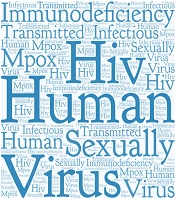The current global outbreak of monkeypox has faced increased prevalence of HIV and other sexually transmitted infections (STIs), affecting mainly bisexuals, gays, and men having sex with men (MSM) (1). There was an association between HIV co-infection and poor clinical outcomes of monkeypox in previous monkeypox outbreaks in Nigeria (2, 3). HIV, monkeypox, and STI monitoring information related to eight US jurisdictions were matched and assessed for the evaluation of HIV and STI diagnosis in monkeypox cases and variations in monkeypox clinical characteristics based on HIV infection status. A prevalence of 38% was reported for HIV in 1,969 cases with monkeypox between May 17 and July 22, 2022, and 41% were diagnosed with one or more other reportable STIs, such as Chlamydia, Gonorrhea, and Syphilis in the previous year. Among cases who had monkeypox and were diagnosed with HIV, 94% were found with the related care in the previous year, and 82% were found with an HIV viral load of < 200 copies/mL, suggesting HIV viral suppression. In comparison with cases who had no HIV infection, most HIV cases were hospitalized (8% vs. 3%). People who have STIs or HIV infection are disproportionately represented among cases suffering from monkeypox. Public health authorities should use systems to deliver and prevent STI and HIV care to decrease the rate of monkeypox in this population. Those who have HIV and STIs should be prioritized for vaccination for monkeypox. Screening for STI and HIV, as well as other preventive strategies, are necessary for cases assessed for monkeypox, with linkage to HIV preexposure prophylaxis (PrEP) or HIV care if necessary.
Also, WHO, in consultation with global experts, will use the novel synonym for monkeypox "mpox", which will be employed at the same time for a year while “monkeypox” is phased out (4).
Out of 1,969 cases who were 18 years and older who had mpox diagnosed between May 17 and July 22, 2022, in eight jurisdictions, 755 cases (38%) had been diagnosed with HIV, 816 cases (41%) had been diagnosed with another reportable STI the previous year, and 363 cases (18%) were found with both; 1,208 (61%) cases had both. As of May 1, 2022, 19 (1%) cases with mpox had been diagnosed with HIV and 297 cases (15%) with STI. Diagnosis of STI in the previous year (48%) was more observed in cases who had mpox and HIV compared to cases who had no HIV infection (37%) (5).
The weekly percentage with co-infection HIV infection showed an increase over time among cases with mpox (31% to 44% by July). The older age groups showed a higher percentage of having mpox and HIV infection: HIV prevalence was 21% and 59% among those aged 18 - 24 and ≥ 55 years, respectively. The prevalence of HIV in people with mpox was different according to race and ethnicity, which was as follows: 63%, 41%, 28%, and 22% among non-Hispanic Black or African American (Black), Hispanic or Latino (Hispanic), non-Hispanic White, and non-Hispanic Asian people (5).
Among 755 cases who had mpox and HIV infection, 713 individuals (94%) were found with HIV care in the past year, 618 cases (82%) showed viral suppression, and 586 cases (78%) were found with CD4 count more than or equal to 350/μL. The median time since the HIV diagnosis was ten years (IQR = 6 to 15 years). Information about HIV PrEP usage was accessible for 172 cases (14%) with no HIV infection, and of these cases 115 cases (67%) experienced current PrEP usage (5).
Compared to those with mpox without HIV infection, rectal pain, purulent or bloody stools, rectal bleeding, tenesmus, and proctitis, were more common in cases with HIV infection, but lymphadenopathy was not reported frequently. Those with mpox with and without HIV infection had similar prevalence of other signs and symptoms. Among 564 cases with known HIV viral load values, mpox, HIV, and symptoms and signs data, purulent or bloody stools, lymphadenopathy, rectal bleeding, and generalized pruritis were more common among 51 cases with unsuppressed HIV viral load compared to 513 people with suppressed viral load. Compared to those who had CD4 counts ≥ 350/μL, cases who had CD4 counts < 350/μL reported generalized pruritis and fever experienced more frequently (5).
The increasing HIV prevalence among cases with mpox over time suggests the increasing transmission of mpox among those with HIV infection. Thus, it is important to provide a prevention delivery system for mpox vaccination and HIV and STI care. STI and HIV screening and other preventive strategies are necessary to cases assessed for monkeypox, with linkage to HIV preexposure prophylaxis (PrEP) or HIV care if necessary.
